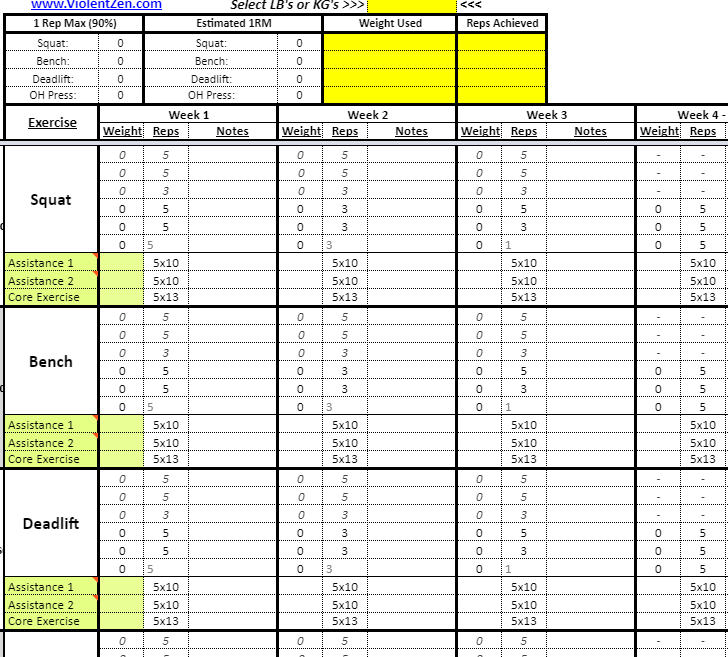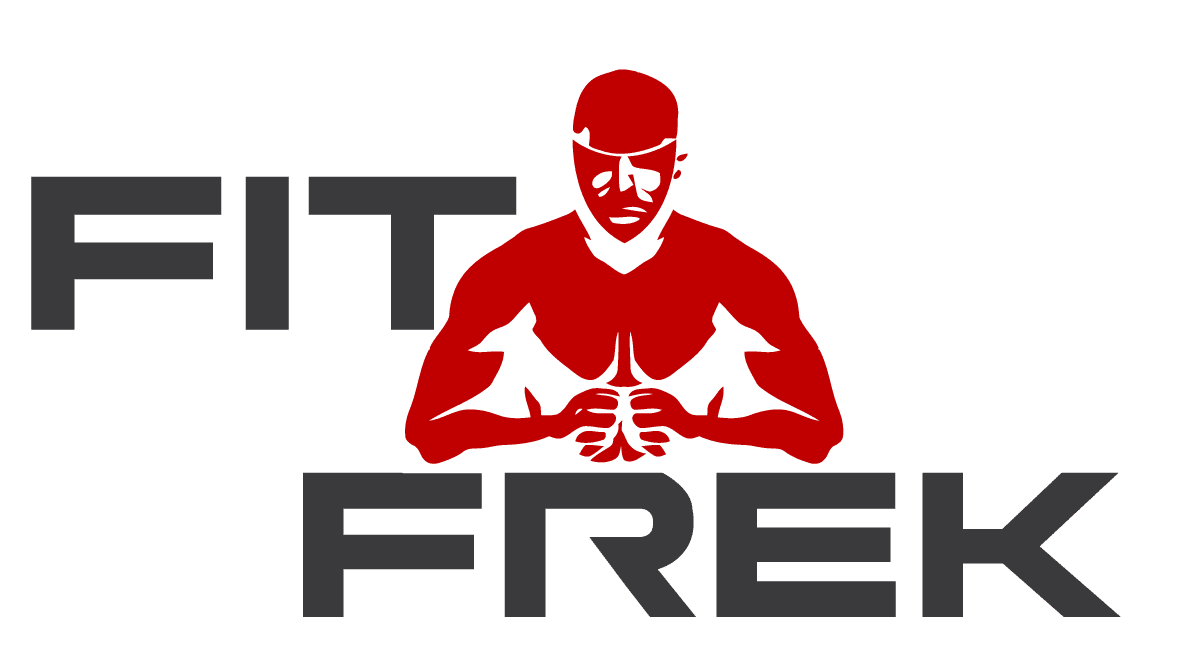

This is a template that comes with multiple variations that'll cater to any level and mostly any goal.
All of them have a few things in common and that's they use the 3 main lifts.
The best variations are collected here with their spreadsheets.
It can be run for however long you want, but it's broken down into 3 and 4 week cycles.
Make sure you make a copy of the spreadsheet. For how to save spreadsheet instructions on mobile, click here, or desktop, here.
Forget a strict program.
The 5/3/1 program comes in so many variations that you'll feel like you're using more of a template.
All the best spreadsheets are collected here.
They focus on the 3 main compound lifts and the original creator, Jim Wendler was the inspiration for programs like GZCL and nSuns.
While you can use the program continuously throughout the year, it's comprised of 3 and 4 week cycles.
If you're already an advanced lifter and want to break plateaus, then check out Building the Monolith.
This is all the literature written by Jim Wendler.
I, among many others, recommend reading these books by Jim Wendler if you wish to make the most out of your training.
Jim Wendler takes all of his principles and explains it in this comprehensive book.
This book is often recommended to read along with Starting Strength and Practical Programming for Strength Training.
Beyond 5/3/1 is a little cheaper than Forever and introduces concepts like First Set last (FSL) and Joker sets that are a part of 5/3/1.
It helps you fully comprehend the principles and philosophies behind 5/3/1.
This is a powerlifting angle to the 5/3/1 for Powerlifting program. The spreadsheet can be found below but you'll get the most by reading the book.
Wendler has designed this program to help you get the most out of your training time.
It's simple but extremely effective and because of it's hardcore simplicity, it brings top notch results.
The BBB variation uses the same 5/3/1 template.
It takes one main lift per workout, either bench, overhead press, deadlift, or squat, and follows with the traditional 5/3/1 rep scheme before decreasing weight and performing 5 sets of 10 reps for the same lift.
It maximizes strength and size through the main lifts, with lots of sets and volume.
Since the training max is increased by month, it's suited best for intermediate to advanced lifter as they can't make progress as fast as beginners.
This is another variation of the program above that is good to use only if it suits your preferences.
The beginner version of the 5/3/1 program uses the same principles as the other variations but it focus more on slow and steady progression.
The spreadsheet calculates the working weights for the “First Set Last”.
First set last takes the weight of the first set that's done for 5 reps in your 5/3/1 set which is set at 65% to 75% of your training max, depending where you are in your training cycle and doing 5 sets of 5 with that weight.
Progression is simple, after 3 weeks, you'll add 10lbs to the training max for deadlift and squats.
For overhead press and bench press, it's 5lbs.
After 2 cycles, which is 6 weeks, you'll take a deload week on the 7th week.
While Jim may have altered his philosophy on deloading, it remains the same, take it easy and let your body recover.
For warm ups, Jim Wendler suggests 10-15 box jumps or medicine ball throws before lifting.
And he also recommends doing Defrancos Agile 8 daily, including as a warm up before training.
On your off days, do some sort of cardio or conditioning but it should be light as it shouldn't interfere with your program.
This is an altered version of the 5/3/1 that puts a couple of foundational principles into one program.
I don't know where this spreadsheet came from but here it is anyway.
Power and Hypertrophy 5/3/1 Program
There's two templates in this spreadsheet:
Normal (vanilla)
This is the main version, unaltered.
The other version is a powerlifting variation, 3/5/1.
The powerlifting variation rotates between week 1 and 2 while using heavy unilateral exercises.
It uses specific powerlifting exercises while maximizing recovery time as it doesn't use heavy lifting weeks.
5/3/1 Vanilla + 3/5/1 Powerlifting Specific Program Variation
The well respected Reddit user u/n-suns created this 5/3/1 variation.
It's different than Jim Wendler's original program.
It aims to maximize progress, further than the original BBB program.
This is great for beginners and intermediate lifters who can take advantage of their quick recovery.
You can check out the other nSuns program here.
For warm up, it's a good idea to take 5-10 minutes to walk until you feel warm.
Once you do that, perform a few light sets of the muscles you're about to workout.
You should do at least 3-4 warm up sets before your actual workout, and then follow the program's workouts.
You can do 1-2 warm up sets before a specific exercise.
The 5/3/1 program is a customizable template that can be used for any goal related to lifting.
It's well liked because it allows the lifter to maximize progress through simplicity.
It's for either because there are so many variations and it can be tailored to any lifting goal and any level.
This is a fair question but it comes down to the variation you use.
The original program only has 3 working sets for each main lift when it was published on T-Nation in 2009.
Wendler then added more volume to the program under a variation called Beyond 5/3/1, which uses “first set last”.
The other variation is to use the Boring But Big spreadsheet that uses multiple things to increase volume.
The foundation of 5/3/1 is used on other popular programs like GZCL and nSuns.
By paying attention to the signs that your body gives you, can prevent a burn out.
Here are some overtraining signs to look out for:
If you ignore these signs and keep exercising, you will eventually hit a plateau and will increase chance of injury.
If you're already experiencing these symptoms, take it easy and avoid pushing yourself for at least a week or two.
The 531 program isn't new.
It's been around, and it's been getting more popular.
Created by strength training guru Jim Wendler, the 531 program is a testament to the philosophy that less is more.
At its core, the 531 program is a straightforward strength training regimen.
It's built around four main lifts: the squat, bench press, deadlift, and overhead press.
The magic of the 531 program lies in its simplicity and its focus on gradual progression.
The "531" in the program's name refers to the rep scheme used in the program.
In each workout, you'll be performing sets of 5, 3, and 1 rep(s), hence the name.
Diving Deeper into the 531 Program
Let's break down the 531 program a bit more.
The program runs in cycles, each lasting four weeks.
Each week focuses on a different rep scheme: 5 reps, 3 reps, and 1 rep, with the fourth week being a deload week.
Each workout focuses on one of the four main lifts.
The squat, bench press, deadlift, and overhead press each get their own day.
The beauty of the 531 program is that it's not just about lifting heavy weights.
It's about lifting smarter, not harder.
The program emphasizes the importance of progressive overload, a key principle in strength training.
In the 531 program, you're not just lifting weights.
You're building strength, one rep at a time.
The Boring But Big (BBB) Variation
Now, let's talk about the Boring But Big (BBB) variation of the 531 program.
The BBB variation takes the original 531 program and kicks it up a notch.
Instead of just doing the main lifts, you'll be adding in additional sets of 5 reps at a lower weight.
This is where the "big" in Boring But Big comes from.
The BBB variation is not for the faint of heart.
It's a challenging program that requires dedication and grit.
But the rewards can be significant.
The additional volume can lead to increased muscle growth and strength gains.
Implementing the 531 Program
So, you're ready to dive into the 531 program.
Great!
But before you do, there are a few things you should know.
First, the 531 program is not a quick fix.
It's a long-term commitment.
You need to be prepared to stick with the program for at least a few months to see significant results.
Second, tracking your progress is key.
Keep a workout log and record your lifts each week.
This will help you see your progress and keep you motivated.
Finally, remember that rest and recovery are just as important as the workouts themselves.
Make sure you're getting enough sleep and eating a balanced diet to support your training.
The 531 Program and Nutrition
When it comes to strength training, what you do outside the gym is just as important as what you do inside it.
And that includes nutrition.
Eating a balanced diet is crucial for fueling your workouts and aiding recovery.
In the 531 program, there's no specific diet to follow.
But a diet rich in protein, complex carbs, and healthy fats will serve you well.
Remember, you're not just lifting weights.
You're building a stronger, healthier body.
And that requires good nutrition.
The 531 Program and Recovery
Recovery is a key component of the 531 program.
After all, you don't get stronger in the gym.
You get stronger when you're resting and your muscles are repairing themselves.
The 531 program includes a deload week every fourth week.
This is a week where you lift lighter weights, giving your body a chance to recover and prepare for the next cycle.
Remember, more is not always better.
Sometimes, less is more.
The 531 Program and Progression
One of the great things about the 531 program is its focus on progression.
Each cycle, you're aiming to lift a little bit more than the last.
This gradual increase in weight is what drives progress in the 531 program.
It's not about lifting the heaviest weights possible.
It's about lifting a little bit more than you did last time.
And over time, those small increases add up to big gains.
The 531 Program and Consistency
The 531 program is not a quick fix.
It's a long-term commitment.
And the key to success in the 531 program is consistency.
You need to stick with the program, even when progress seems slow.
Remember, strength training is a marathon, not a sprint.
Stay consistent, and you'll see results.
Useful Links
 About FitFrek
About FitFrekFitFrek operates as an independent platform, offering comprehensive workouts, programs, routines, guides, and unbiased reviews to accelerate your progress. We pride ourselves on our honesty, delivering straightforward and candid insights. FitFrek does not offer medical advice, diagnosis, or treatment services.